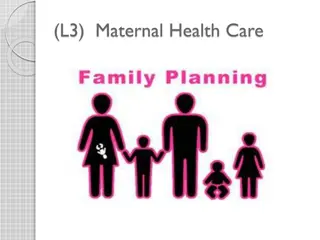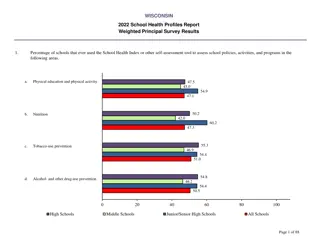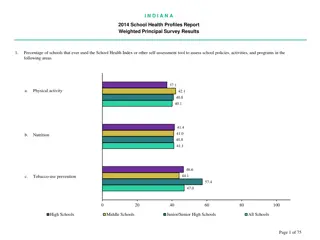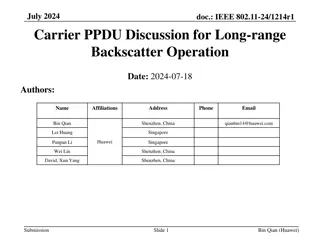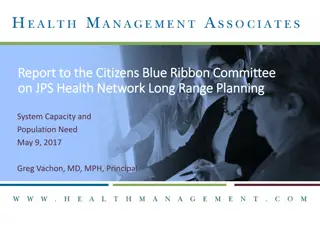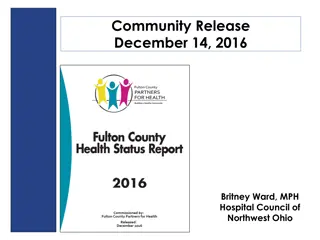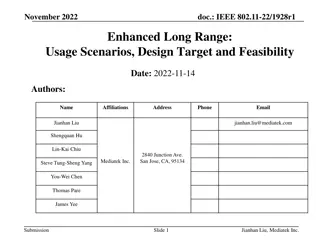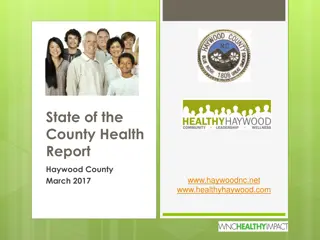JPS Health Network Long Range Planning Report
The report prepared by HMA for the Tarrant County Hospital District outlines key findings and recommendations for the JPS Health Network's long-range planning. It highlights the importance of addressing changing demographics, expanding health professions training programs, and adapting to evolving healthcare delivery needs. The report emphasizes the critical role of JPS in providing safety net care and underscores the need for strategic planning to meet the future healthcare demands of Tarrant County.
Download Presentation

Please find below an Image/Link to download the presentation.
The content on the website is provided AS IS for your information and personal use only. It may not be sold, licensed, or shared on other websites without obtaining consent from the author.If you encounter any issues during the download, it is possible that the publisher has removed the file from their server.
You are allowed to download the files provided on this website for personal or commercial use, subject to the condition that they are used lawfully. All files are the property of their respective owners.
The content on the website is provided AS IS for your information and personal use only. It may not be sold, licensed, or shared on other websites without obtaining consent from the author.
E N D
Presentation Transcript
Report to the Citizens Blue Ribbon Committee Report to the Citizens Blue Ribbon Committee on JPS Health Network Long Range Planning on JPS Health Network Long Range Planning Overall Recommendations June 6, 2017 Greg Vachon, MD, MPH, Principal Lori Weiselberg, MPH, Principal
INTRODUCTION In August 2016, the Tarrant County Commissioners Court contracted with HMA to develop a Long Range Planning and Analysis for the Tarrant County Hospital District d/b/a JPS Health Network. The charter established for HMA s work: Tarrant County, with the assistance of JPS Health Network, is looking into the future to anticipate changes in population demographics/growth, technology and how we provide healthcare services. With this information, the Tarrant County Commissioners Court will be able to make informed decisions to improve the health status of the County. 2
HMA APPROACH HMA conducted research, engaged stakeholders, developed findings, and provided recommendations for action organized in several focus areas that form the chapters of this report: 1. 2. 3. 4. 5. 6. 7. Voices of the Community: Stakeholder Engagement Process Macro Trends in United States Health Care Delivery Community Health Needs Assessment System Capacity and Population Needs Market Assessment: Medical Staff and Medical Education JPS Delivery System including major service lines, JPS strategic plans Tarrant County Public Health: Role and Relationship with JPS Health Network Market Assessment: Financial Perspectives 8. 3
KEY FINDINGS JPS Health Network is a strong, academic, public hospital system that provides a very large proportion of the safety net care in Tarrant County. JPS is critical to the county and is recognized and valued by residents, public health, social service and other hospitals and health care providers. 4
KEY FINDINGS Demographics are changing. The County s population is expected to grow over 46% in the next 20 years from 2M in 2017 to 2.95M in 2037. The Medicare eligible population is expected to increase sharply -- 41% between 2015 and 2021. The population will grow increasingly diverse highest growth rates in Hispanic, Asian, and Black populations. The rapid growth, aging and diversity of the Tarrant County population in the coming decades, and changes in the health care delivery system and financing environment requires JPS and others to focus on several priorities simultaneously. 5
RECOMMENDATIONS: HEALTH PROFESSIONS TRAINING A key priority is ensuring an adequate future health care workforce by expanding and strengthening JPS health professions training programs; public hospitals that do not have teaching programs or properly invest in those programs are not sustainable. 6
RECOMMENDATIONS: AMBULATORY CARE Other critical priorities include: expanding ambulatory care in communities of greatest need including primary care medical homes diversion programs (inpatient and criminal justice), behavioral health integration in existing and new medical homes, specialty behavioral health and substance use services, and psychiatric evaluation centers (PECs) addressing anticipated shortages in specialty care through strong recruitment programs and partnerships with other provider organizations 7
RECOMMENDATIONS: MEDICAL INPATIENT FACILITIES EXPANSION Replace and expand JPS acute medical inpatient facilities. Extrapolating from the JPS Connection population, HMA estimates 594 beds will be needed for JPS to meet the needs of current population percentage (34%) 20 years in the future. This includes an aggressive admission/LOS reduction of 1% per year. This 185 additional beds with this most conservative outlook. When Blue Cottage report estimates of LOS reduction are used, the estimate is adjusted to 664 beds needed. Since the percentage of population need met is low and an increase in the commercial/Medicare payer component is recommended, an acceleration of the shell space build out is reasonable. 8
RECOMMENDATIONS: PSYCHIATRIC INPATIENT FACILITIES EXPANSION Replace/renovate and expand JPS psychiatric inpatient facilities HMA estimates 516 beds needed for JPS to meet 50% of population need 20 years in the future. This is based on 35 public beds per 100,000 population which assumes 50% reduction of need (below the literature-supported level of 70 beds per 100,000) through pursuing investments in outpatient behavioral health services. This degree of reduction assumed is not literature- supported, but rather is expert opinion of the maximum effect. The 132 psychiatric beds will only fulfill 26% of the 516 beds defined above. To remain at current 37% of calculated need would take an additional 59 beds. 9
RECOMMENDATIONS: POSITION FOR VALUE-BASED REIMBURSEMENT Other key priorities include preparing JPS, as an integrated health system, for value-based reimbursement and risk-based managed care in part by: optimizing primary care patient panels, and using information technologies and data analytics for population health management and for identifying and enrolling high-risk patients in a robust care management program. 10
RECOMMENDATIONS: SERVICE LINE DEVELOPMENTS A clear need in the community as a whole is behavioral health capacity; JPS is well positioned to lead the development of a county-wide behavioral health system of care with a focus on expanding prevention and wellness programming, and outpatient services. HMA also recommends JPS designate cancer care and geriatrics as high priority service line developments supported by appropriate facilities. 11
RECOMMENDATIONS: PROMOTING HEALTH Hospital systems are shifting from focusing solely on sick care to promoting health. HMA encourages JPS to continue to build and strengthen partnerships with diverse communities, public health and social service organizations, as well as other hospital systems to increase efforts in: disease prevention, and address social determinants of health -- through health policy and other means -- including public transit to improve access to its services. 12
RECOMMENDATIONS: PAYOR MIX JPS serves a large proportion of individuals that are low- income, uninsured, and covered by Medicaid. Market share for Medicaid/Uninsured discharges combined is 55% Only 13.7% commercially insured and 6.1% Medicare discharges JPS has three major revenue streams: Net Patient Service Revenues (NPSR): 43.7% Property Tax Revenue: 37.9% Supplemental Medicaid Funding: 18.4% The long-term financial health of JPS Health Network would be much improved if it were to increase its market share of Medicare, Exchange, and private sector revenues. This would allow JPS to develop and sustain a patient-based revenue flow that is less dependent upon on property taxes or on increasing Medicaid supplemental funding. 13
RECOMMENDATIONS: FACILITIES Finally, facilities that meet today s standards will result not only in operational efficiencies, but an improved patient care environment allowing JPS to better serve the County s residents now and in the future. 14
DISCUSSION Question and Answer Discussion 15
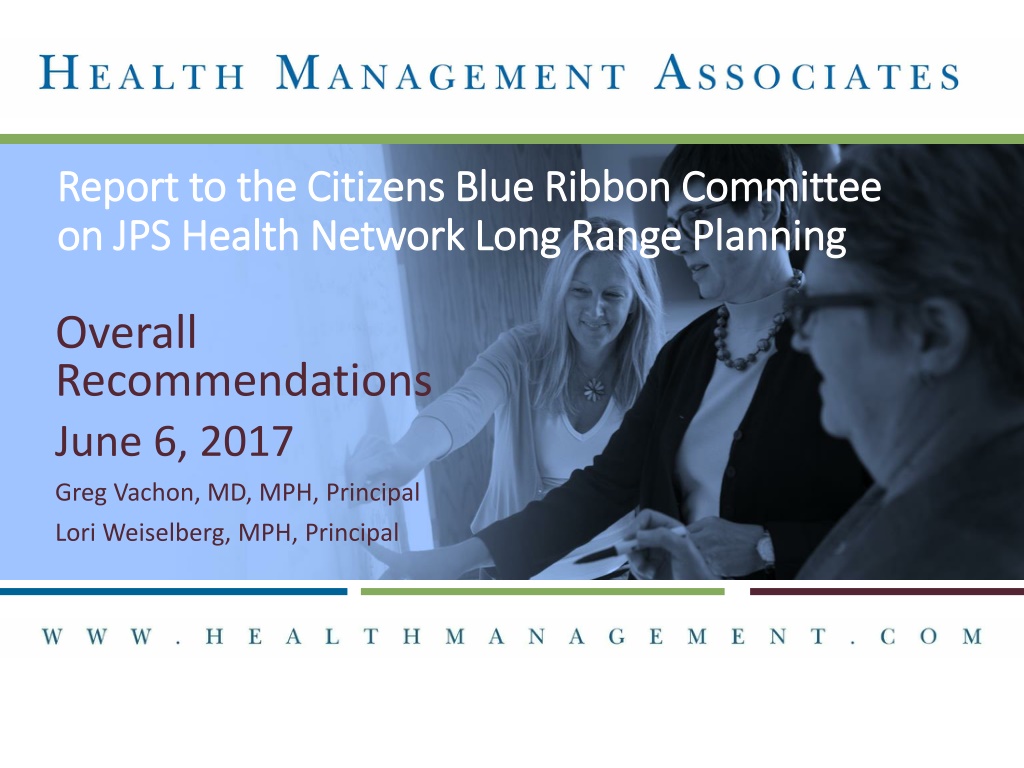














![Long-Range Wireless Charging Market Report & Analysis _ BIS Research [2024-2035]](/thumb/87166/long-range-wireless-charging-market-report-analysis-bis-research-2024-2035.jpg)
